|
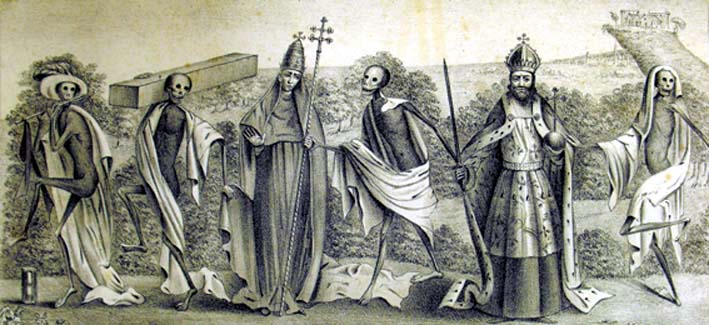
A graphic illustration of
the mural at Lubeck (Gemmell Add f.9) |
The Dance of Death motif has its origins in medieval
society. Although (as scholars such as Francis Douce and Marcia
Collins point out) civilizations had been anthropomorphosising
death for centuries, the Dance is a later concept.
The earliest example of the Dance in graphic art was as an
architectural mural on the walls of the Holy Innocents Church in
Paris in 1424/5. The genre subsequently spread throughout
northern Europe, and similar frescoes appeared in Germany,
Switzerland and even England. Famous Dances of Death were on
view in Basel (after 1440) and Lubeck (after 1463), as well as
on covered bridges at Lucerne (c.1400) and Spruer. Around 1430 a
Dance of Death could also be observed on the cloisters of the
old St. Paul's in London; this was accompanied by French verses
translated into English by John Lydgate.
It is suggested that the Dance's origins may be traced back
to medieval drama. It is known that actors performed the parts
of various members of society being taken by death in a dialogue
between Death and his victims. Janet Barnes, for instance,
claims that the Dance was first recorded as a liturgical drama
to illustrate sermons in Normandy in 1393, predating its
appearance on the church walls in Paris.
|
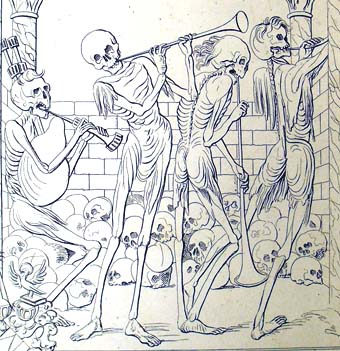
Examples of fresco at
Bern (Gemmell Add f.10) |
|
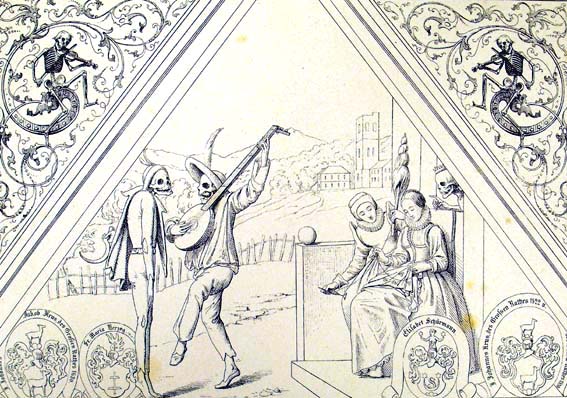
Reproduction of the Dance of Death fresco at Lucerne (Gemmell
f3)
|
The impetus behind the development of the Dance
remains unclear, yet the historical context is crucial. As
Gundersheimer remarks, the 15th Century was a time of crop
failure, climate change, pestilence, the Black Death and the
Hundred Years' War. The mortality rate was significantly high
and the average man could only expect to live to 50. Public
executions were commonplace and, unlike today, a person could not
expect to reach adulthood without having seen a dead body. |
|
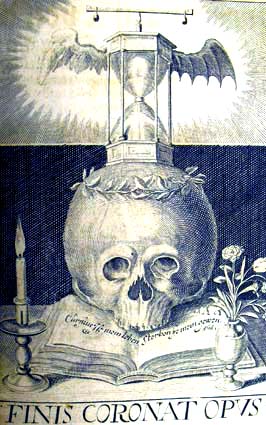
Memento Mori plate
(Gemmell 6)
|
But was the Dance of Death intended as a comfort or a
warning?
On one hand, it offers the consolation that regardless of
one's status in the mortal life, all are equal before death. It
is possible that in bleak times the Dance extended an invitation
to laugh at death and an encouragement to live in the moment.
Yet it also constitutes a stark reminder of impending death,
and serves a didactic function in reminding the viewer to live
and die well. As these two plates show, the Dance could serve as
a momento mori in an age when death could strike at any time.
James Clark concludes that in classical times the memento mori
maxim was an incitement to "eat, drink and be merry;" yet in the
Middle Ages, it became a warning to live a purposeful life.
|
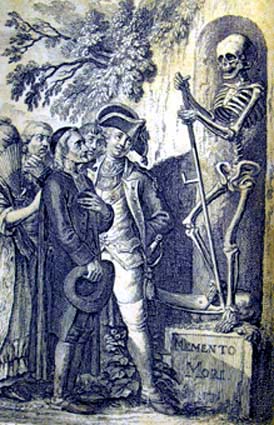
Memento Mori frontispiece plate (Gemmell 14) |
| Yet the interest in the portrayal of death, and
the continued reinvention of the Dance of Death in centuries
that had long-since forgotten the famines and plagues of the
Middle Ages, ultimately demonstrates the universality of man's
preoccupation with death and mortality. The following pages
explore how this medieval theme found its way into print and
continued to thrive through the ages. |
|